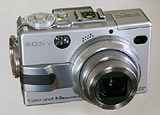|
Jump
All photos by the author. |
The Second Annual Road Trip and Vacation Travel Digital Camera Shootout is finished. Here's the report: When you lug a trunkload of digital cameras into the hinterlands, you expect results, results, results. And with a number of cameras to choose from, results are pretty much guaranteed, but what if you don't want to carry a fifteen pound bag of technology around with you, the way the working pros do, and you still want results? Then the one camera you carry had better deliver.
So I packed up no less than six champion digital cameras and set out for views unknown where the treasures of travel awaited. I'm one of those tourists who walks the walk and shoots the shot. My returning luggage is full of... the same things it started out with, only dirtier. Souvenirs? Those are for people who can't hold a camera--or don't know what to shoot or why. I'm never going to look at that souvenir East Berlin, Soviet-era corkscrew and go, "Hey, sweetie... remember that bottle we polished off on the Rhine?" Then again, maybe I will, but that's not a photo story... The cameras:
When traveling, you move. No revelation there, but unless you stop for a reason, you probably won't appreciate any accessory that halts your flow. I can count the number of tripod shots on the fingers of one hand. But the number of stabilized shots was relatively large. The number of times I used a converter optic was also extremely low. The built-in features of the cameras was where life began and 99%+ of all images used nothing more than the camera's own inherent qualities to obtain the shot. When in Amsterdam, there are museums you'll never see anywhere else, but that's true for any city. So we often go to these storehouses of local--or concentrated--culture to see if the famous whatever-it-is is worth seeing. Kind of a Catch-22. But most of the time it is indeed worth the effort, and there is always something unexpectedly rich in the experience.
Of course flash shots are out. They can set off alarms or blind guards if used inappropriately, not to mention the sheer annoyance they cause other visitors, so museum shooting should be sans-blast. I've developed the uncanny ability to not see "no photography" signs, and without flash calling attention to my shots, I've never been hassled. Inevitably about halfway through a venue that is anti-photo, I'll spot a sign and put the gear away. Berlin's Agyptisches Museum (Egyptian artifacts, left) has no problem with photos--just flash. They've done so well with lighting that flash would only ruin the picture.
All of these cameras shoot great images. Some are better than others in specific areas. For instance, the least-shot camera in the group is the King of Macro, the CP4500. Vacation and travel photography is generally not about tiny things, so other cameras ended up acing this one out of the running with their more current features, frame sizes, ergonomics or other factors. But what if it had been the only one? Most of the photo situations would still be preserved well. Why was it used so little? Each day I took three cameras with me. After a while it became obvious which ones I wanted the most. The others were buried in luggage. On most days, the 4500 was in the luggage. But it had great company... The next-least used was the CP5000. Mostly because its single trick was that amazing WC-E68 Ultra Wide Angle converter optic. That optic lives its entire life on my CP5000 serving as a zoom widener. In doing so, it makes the camera "cubic," meaning that it will never, ever, under any circumstances, fit in a pocket. But its native 28mm (equivalent) wide zoom position was used thousands of times. Just not with this camera body. The CP5400 has the same wide zoom position, and that's where the work was so often done. If you had the CP5000 on a vacation, you could have achieved nearly all the pictures that came back, so it gets high marks, but it has been transcended by the newer model 5400. The four remaining cameras were appreciated because of special qualities. Two Nikons and two Sony's made the first cut. Here are some of their shots:
|

 DSC-V1
DSC-V1 CP5000.
CP5000. CP5700.
CP5700. CP5400.
CP5400. My general experience
with these digital cameras is embodied in the eBooks available
here, but when traveling, general experiences aren't the rule.
Travel photography is opportunistic photography and you never
know what you're walking into. Unless you are shooting images
of your travel companions, flash-blast photos are probably not
going to be appreciated by the candid local population. I packed
flash units that were never touched.
My general experience
with these digital cameras is embodied in the eBooks available
here, but when traveling, general experiences aren't the rule.
Travel photography is opportunistic photography and you never
know what you're walking into. Unless you are shooting images
of your travel companions, flash-blast photos are probably not
going to be appreciated by the candid local population. I packed
flash units that were never touched. Side Note: About half
the museums in the world don't "get it." The "it"
being that people want to shoot pictures of their experiences,
meaning the museum's collection.
Side Note: About half
the museums in the world don't "get it." The "it"
being that people want to shoot pictures of their experiences,
meaning the museum's collection. Experiences:
Experiences:


 Get the eBooks
Get the eBooks